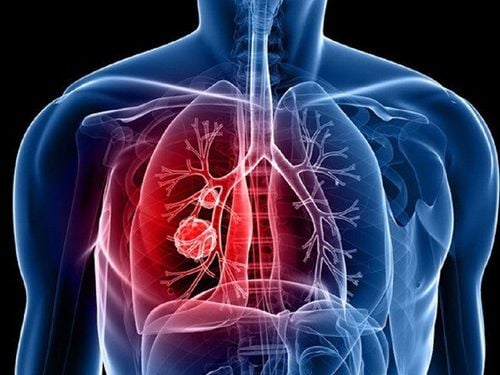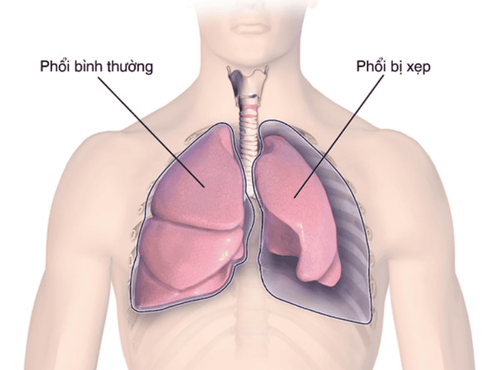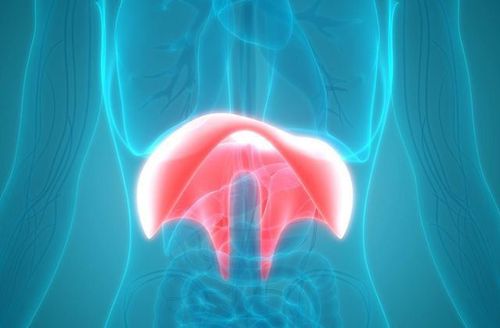This is an automatically translated article.
The article was professionally consulted by Dr. Phan Dinh Thuy Tien - General Internal Medicine - Department of Examination & Internal Medicine - Vinmec Nha Trang International General Hospital.Atelectasis is caused by the collapsed alveoli in the lungs, causing difficulty breathing, chest pain, and can even lead to dangerous complications such as: pneumonia, respiratory failure... The disease can be cured in adults with: a very small amount. Therefore, when there are signs of the disease, it is necessary to see a doctor for timely testing, diagnosis and treatment to avoid serious risks.
1. What is atelectasis?
Atelectasis is the complete or partial collapse of the entire lung or an area (lobe) of the lung. It occurs when the small air sacs (alveoli) in the lungs become deflated or may fill with alveolar fluid.Atelectasis is one of the most common breathing (respiratory) complications after surgery. It is also a possible complication of other respiratory problems, including cystic fibrosis, lung tumors, chest trauma, fluid in the lungs, and respiratory failure. Illness can also occur when a foreign object is inhaled.
Atelectasis can interfere with the airway, especially if there is additional lung disease. Treatment for this condition depends on the cause and severity of the atelectasis.
2. Causes of atelectasis
There are many causes of a collapsed lung. Depending on the cause can be classified into obstructive and nonobstructive atelectasis2.1. Causes of Obstructive Atelectasis Obstructive atelectasis occurs when one of the airways is blocked. This prevents air from entering the alveoli and so they collapse. Obstacles that can prevent air from entering the airways include:
Inhaling foreign objects such as small toys or small pieces of food into the airways. Accumulation of mucus (mucus plug) in the airways. Tumors grow in the airways. Tumor in lung tissue pressing on airways.

Khối u trong mô phổi gây xẹp phổi tắc nghẽn
Surgery: Trauma can happen during or after any surgery. These surgeries often involve the use of anesthesia and a ventilator, followed by pain medication and sedation. Together these can make breathing shallower. They can also make people cough less often, even when they need to be removed from their lungs. Sometimes, not breathing deeply or not coughing can cause some of the alveoli to collapse.
If you have an upcoming surgery, talk to your specialist about ways to reduce your risk of post-operative atrophy. Currently, there is a portable device called a spirometer. This machine can be used in hospitals and at home to help with deeper breathing.
Pleural effusion: This is a buildup of fluid in the space between the outer lining of the lung and the lining of the inner chest wall. Normally, these two linings will be in close contact to help keep the lungs open. Pleural effusion causes the linings to separate and lose contact with each other. This allows the elastic tissue in the lungs to pull inward, pushing air out of the alveoli.
Pneumothorax: This is very similar to a pleural effusion but involves a buildup of air, rather than fluid, between the lining of the lungs and the chest. Like a pleural effusion, this causes lung tissue to pull inward, pushing air out of the alveoli.
Lung scarring: Lung scarring is also known as pulmonary fibrosis. It is usually caused by a long-term lung infection, such as tuberculosis. Long-term exposure to irritants, including cigarette smoke, can also cause it. This scar is permanent and makes it harder for your alveoli to swell.
Chest tumor: Any mass or growth that is near the lungs can put pressure on the lungs. This can force some air out of the alveoli, causing them to deflate.
Lack of surfactant (Surfactant): The alveoli contain a substance called surfactant that helps them stay open. When there is too little of this substance, the alveoli collapse. Surfactant deficiency tends to occur with infants born prematurely.

Có nhiều nguyên do khác nhau gây xẹp phổi
3. Symptoms of atelectasis
Symptoms of atelectasis range from none to very severe and depend on how much the lung is affected and how fast it is growing. If only a few alveoli are involved or it happens slowly, there may not be any symptoms. When atelectasis involves a lot of alveoli or comes on quickly, it can be difficult to get enough oxygen into the bloodstream. Low blood oxygen can lead to:Shortness of breath. Severe chest pain, especially when taking a deep breath or coughing. Breathe fast. Increase heart rate. Blue skin, lips, fingernails or toenails. Occasionally, pneumonia will develop in the affected parts of the lung. When this happens, there may be typical pneumonia symptoms, such as cough, fever, and chest pain.
4. Risk factors for atelectasis
Factors that are more likely to develop atelectasis include:Advanced age. Any condition that causes difficulty swallowing. Little change of position, mostly lying motionless in bed. Lung disease, such as asthma, COPD, bronchiectasis, or cystic fibrosis. Abdominal or chest surgery. General anesthesia. Weak breathing (respiration), muscular dystrophy, spinal cord injury, or another neuromuscular condition. The drug may cause shallow breathing. Pain or injury can cause pain when coughing or shallow breathing, including stomach upset or broken ribs. Smoke.
5. Complications of atelectasis
A small number of atelectasis, especially in adults, are usually treatable. The following complications can result from atelectasis:Low blood oxygen (hypoxia): Atelectasis makes it harder for the lungs to get oxygen into the air sacs (alveoli). Pneumonia: The risk of pneumonia continues until treatment is stopped. Mucus in the collapsed lungs can lead to an infection. Respiratory failure: Loss of a lobe or all of a lung, especially in infants or people with lung disease, can be life-threatening.

Xẹp phổi gây biến chứng suy hô hấp
6. Preventing atelectasis
Children who swallow foreign bodies such as peanuts, small objects can cause atelectasis due to airway obstruction. To reduce the risk of illness, keep small objects out of the reach of children.In adults, anemia often occurs after major surgery. If surgery is planned, talk to your specialist about strategies to reduce risk. Some research suggests that having certain breathing and muscle exercises can reduce the risk of disease after certain surgeries.
Doctor Thuy Tien has 18 years of experience in medical examination and treatment. Currently working as a General Internal Medicine Doctor, Department of Medical Examination and Internal Medicine, Vinmec Nha Trang International General Hospital.
Please dial HOTLINE for more information or register for an appointment HERE. Download MyVinmec app to make appointments faster and to manage your bookings easily.
Reference source: mayoclinic.org; webmd.com; healthline.comMORE:
Atelectasis: Diagnosis and treatment Long-term complications of asthma Complications and consequences of pleural effusion













